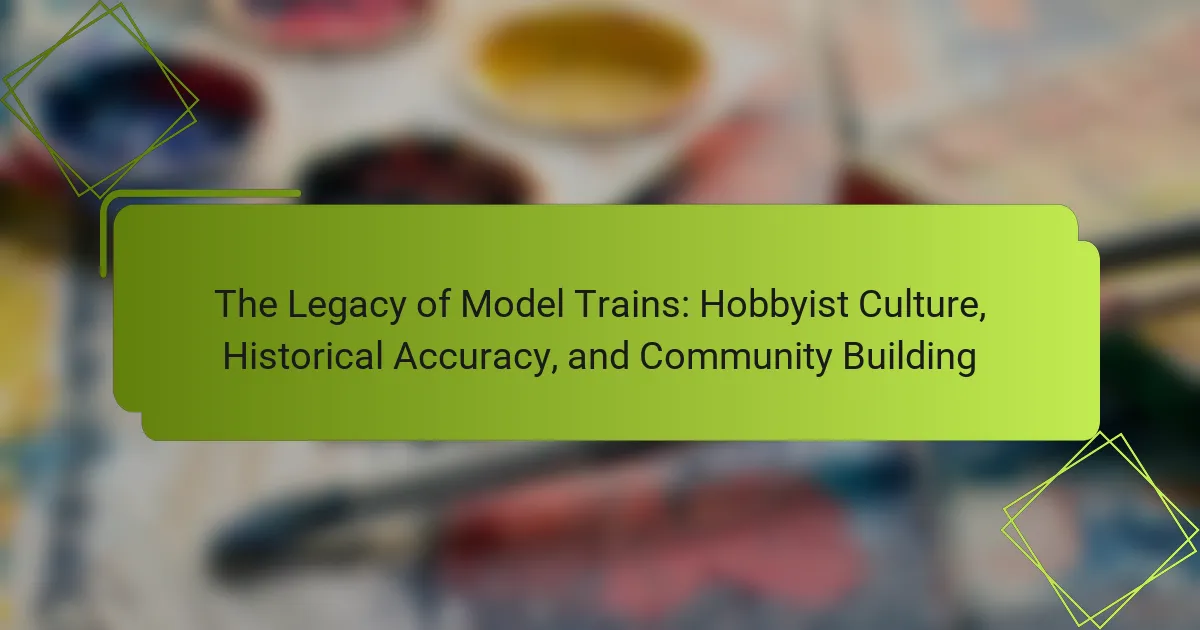
What is the Legacy of Model Trains?
The legacy of model trains encompasses their role in hobbyist culture, historical preservation, and community engagement. Model trains have been a popular hobby since the early 20th century. They allow enthusiasts to recreate historical railways and landscapes. This fosters a deeper appreciation for railway history and engineering. Model trains also serve as a medium for artistic expression and craftsmanship. The hobby promotes social interactions through clubs and exhibitions. Events like model train shows gather enthusiasts to share knowledge. This community aspect strengthens bonds among participants. Overall, model trains have left a lasting impact on culture and social connections.
How did model trains become a significant hobby?
Model trains became a significant hobby due to their accessibility and the rise of miniature modeling in the early 20th century. The introduction of electric trains in the 1920s made them easier to operate. This innovation attracted a wider audience, including children and adults. The Great Depression further popularized model trains as an affordable pastime. Post-World War II, the hobby grew with increased disposable income and leisure time. The establishment of clubs and exhibitions fostered community engagement. Today, model trains are celebrated for their craftsmanship and historical accuracy. They serve as a medium for creativity and social interaction among enthusiasts.
What historical events influenced the popularity of model trains?
The popularity of model trains was influenced by several historical events. The Industrial Revolution in the 19th century increased railway construction. This led to a fascination with trains as symbols of progress. The introduction of electric trains in the early 20th century made model trains more accessible and easier to operate. The post-World War II economic boom allowed more families to invest in hobbies, including model trains. Additionally, the rise of toy manufacturers like Lionel and Märklin popularized model trains in the mid-20th century. The growth of model train clubs and exhibitions further fostered community engagement. These events collectively shaped the model train hobby into a widespread cultural phenomenon.
How have technological advancements shaped model train hobbies?
Technological advancements have significantly transformed model train hobbies. Innovations such as digital command control (DCC) allow precise control of multiple trains on the same track. This technology enhances realism and operational complexity. Moreover, 3D printing has enabled hobbyists to create custom parts and models easily. The availability of online resources and forums fosters community engagement and knowledge sharing. High-definition sound systems have improved the auditory experience of model trains. Additionally, advancements in materials have led to more durable and realistic models. These developments contribute to a richer, more immersive hobby experience for enthusiasts.
Why is historical accuracy important in model trains?
Historical accuracy is important in model trains because it enhances the authenticity of the hobby. Accurate models reflect real historical locomotives and railroads. This connection to history enriches the experience for hobbyists. It allows them to appreciate the evolution of rail transport. Furthermore, historical accuracy fosters a sense of community among collectors and enthusiasts. They often share knowledge and resources related to specific periods and styles. Accurate representations can also increase the value of models in the collector’s market. Thus, the emphasis on historical accuracy plays a crucial role in the model train community.
What are the standards for historical accuracy in model train design?
Standards for historical accuracy in model train design include scale fidelity, detail replication, and adherence to historical context. Scale fidelity refers to the accurate representation of size in relation to real trains. Detail replication involves reproducing specific features such as paint schemes, logos, and physical dimensions. Adherence to historical context ensures that models reflect the correct time period and geographical location.
For example, a model of a steam locomotive from the 1940s must resemble the design and color schemes used during that era. Additionally, manufacturers often consult historical documents and photographs to ensure authenticity. This commitment to detail is critical for hobbyists who value realism in their collections. Accuracy in model trains enhances both the enjoyment and educational value for collectors and enthusiasts.
How do hobbyists ensure their models reflect historical realities?
Hobbyists ensure their models reflect historical realities by conducting thorough research. They study historical documents, photographs, and blueprints related to the era they wish to replicate. Many hobbyists participate in online forums and local clubs to share knowledge and resources. They often consult experts in historical modeling or specific periods.
Additionally, hobbyists may use reference materials such as books and documentaries. Some even visit museums or historical sites for firsthand observation. They pay close attention to details like color schemes, materials, and construction techniques used in the original models. This commitment to accuracy helps them create authentic representations of historical trains and landscapes.
What role does community play in model train culture?
Community plays a vital role in model train culture by fostering connections among enthusiasts. It provides a platform for sharing knowledge, experiences, and resources. Clubs and online forums facilitate collaboration on projects and layouts. Events like train shows and exhibitions create opportunities for social interaction. These gatherings promote learning and inspire creativity among hobbyists. Shared interests lead to lasting friendships and mentorship opportunities. The community also supports the preservation of historical accuracy in modeling. Collectively, members advocate for the hobby and its growth. Overall, community strengthens the model train culture significantly.
How do clubs and organizations foster a sense of community among hobbyists?
Clubs and organizations foster a sense of community among hobbyists through shared interests and collaborative activities. They provide a platform for individuals to connect over a common passion, such as model trains. Regular meetings and events encourage interaction and relationship-building. Workshops and group projects enhance teamwork and skill-sharing. These activities create a supportive environment where members can learn from each other. Social events, such as train shows, further strengthen bonds among participants. Research shows that engagement in hobbyist communities leads to increased satisfaction and a feeling of belonging. The National Association of Model Railroaders highlights that members often form lasting friendships through their shared experiences.
What events and exhibitions bring model train enthusiasts together?
Events and exhibitions that bring model train enthusiasts together include national conventions, regional train shows, and local club meetups. The National Model Railroad Association (NMRA) hosts an annual convention that attracts thousands of hobbyists. Trainfest, held in Wisconsin, is one of the largest model train shows in the U.S., featuring numerous vendors and layouts. Additionally, local train clubs often organize open houses and swap meets, fostering community engagement. These gatherings provide opportunities for enthusiasts to share knowledge, showcase their layouts, and purchase supplies. The camaraderie at such events reinforces the strong community among model train hobbyists.

How does model train culture evolve over time?
Model train culture evolves over time through technological advancements, changing hobbies, and community engagement. Initially, model trains were simple mechanical toys. As technology progressed, electric trains emerged, enhancing realism and interactivity. The introduction of digital command control revolutionized operations, allowing for more complex layouts.
Hobbyist interests have shifted, with a growing focus on historical accuracy and craftsmanship. This shift has led to the production of more detailed models and accessories. Online communities and social media have also transformed how enthusiasts connect and share knowledge. Events like train shows and exhibitions foster collaboration and innovation.
Overall, model train culture reflects broader societal changes while maintaining a strong sense of tradition.
What trends have emerged in the model train hobby?
In recent years, several trends have emerged in the model train hobby. Digital technology integration is a significant trend. Many hobbyists now utilize digital command control (DCC) systems for enhanced operation. This allows for more intricate control of multiple trains on the same track. Additionally, 3D printing has gained popularity among modelers. It enables enthusiasts to create custom parts and models tailored to their specific needs.
Sustainability is also becoming a focus. More hobbyists are seeking eco-friendly materials and practices. The rise of online communities has transformed social interactions within the hobby. Platforms like social media and forums allow for sharing ideas and resources. Furthermore, there is an increased interest in historical accuracy. Modelers are investing time in researching and replicating real-life trains and landscapes.
These trends reflect a growing intersection of technology, community, and a commitment to authenticity in the model train hobby.
How have social media and online platforms impacted model train communities?
Social media and online platforms have significantly transformed model train communities. They facilitate instant communication among hobbyists across the globe. Platforms like Facebook, Instagram, and dedicated forums allow for the sharing of tips, techniques, and project showcases. Users can easily post pictures and videos of their layouts, enhancing visual engagement. Online groups provide a space for discussions on historical accuracy and modeling techniques. This fosters a collaborative environment where members can learn from each other. Additionally, social media has enabled the organization of virtual events and meetups. These connections have revitalized interest in the hobby, attracting new enthusiasts. Overall, social media has made model train communities more accessible and interactive.
What new materials and techniques are changing model train construction?
New materials and techniques are significantly changing model train construction. 3D printing allows for custom parts and intricate designs. This technology enables hobbyists to create unique components tailored to specific needs. Advanced plastics provide durability and reduce weight in models. These materials often mimic the look of metal without the associated costs. Digital command control (DCC) enhances the operational capabilities of trains. DCC systems allow for more precise control of speed and direction. Laser cutting techniques also improve accuracy in creating detailed scenery and structures. These innovations contribute to a more realistic and engaging model train experience.
How do hobbyists share their passion for model trains?
Hobbyists share their passion for model trains through various channels. They participate in online forums and social media groups dedicated to model trains. These platforms allow them to exchange ideas, showcase their layouts, and discuss techniques. Model train exhibitions and conventions also provide opportunities for enthusiasts to connect in person. At these events, they share tips, display their collections, and network with other hobbyists. Additionally, many hobbyists create YouTube channels or blogs to document their projects. This content often includes tutorials, reviews, and showcase videos. Such platforms help spread knowledge and foster a sense of community among model train enthusiasts.
What are the most popular platforms for showcasing model train layouts?
The most popular platforms for showcasing model train layouts include social media, dedicated forums, and video-sharing sites. Social media platforms like Instagram and Facebook allow users to share photos and connect with other hobbyists. Dedicated forums such as Model Railroader and The Gauge provide spaces for discussion and layout showcases. Video-sharing sites like YouTube are popular for tutorials and layout tours. These platforms facilitate community building among model train enthusiasts. They also support sharing of historical accuracy and creative designs.
How do tutorials and workshops enhance the learning experience for newcomers?
Tutorials and workshops enhance the learning experience for newcomers by providing structured guidance and hands-on practice. They allow newcomers to learn from experienced individuals in a supportive environment. This interaction fosters community building among hobbyists. Workshops often include demonstrations, which clarify complex concepts. Tutorials can break down intricate tasks into manageable steps. Research shows that active participation in learning enhances retention and understanding. A study by the National Training Laboratory found that people retain 75% of what they learn through practice. This method is particularly beneficial in hobbies like model trains, where practical skills are essential.

What are the challenges faced by model train enthusiasts?
Model train enthusiasts face several challenges. One significant challenge is the high cost of acquiring quality models and accessories. Prices for detailed locomotives and rolling stock can range from hundreds to thousands of dollars. Another challenge is the complexity of building and maintaining layouts. Enthusiasts often require extensive knowledge of electrical systems and scenery construction. Space limitations can also hinder hobbyists. Many enthusiasts struggle to find adequate room for large layouts in their homes. Additionally, sourcing specific parts or models can be difficult. Some items may be discontinued or hard to find. Lastly, keeping up with technology advancements poses a challenge. Digital command control systems require ongoing learning and investment. These challenges can impact the overall experience for model train enthusiasts.
What common obstacles do hobbyists encounter in their modeling journey?
Hobbyists encounter several common obstacles in their modeling journey. One major challenge is the lack of time due to other commitments. Many hobbyists struggle to balance their modeling with work and family responsibilities. Another obstacle is the high cost of materials and tools. Quality modeling supplies can be expensive, which may deter hobbyists from pursuing their passion.
Additionally, hobbyists often face difficulties with skill development. Learning new techniques can be time-consuming and frustrating. Access to resources or guidance is sometimes limited, making it harder for beginners to improve. Another issue is the complexity of projects. Large or intricate models can overwhelm hobbyists, leading to unfinished work.
Lastly, some hobbyists encounter community-related challenges. Finding local groups or clubs can be difficult, which may limit social interaction and support. These obstacles can hinder the overall enjoyment and progression of hobbyists in their modeling journey.
How can hobbyists overcome the challenges of space and budget?
Hobbyists can overcome challenges of space and budget by utilizing modular layouts and prioritizing essential tools. Modular layouts allow for flexibility in design and easy storage. This approach helps to create a train setup that can be expanded or reduced based on available space. Prioritizing essential tools ensures that hobbyists invest only in necessary items, reducing overall costs.
Additionally, sharing resources within a community can lower expenses. Collaborating with fellow enthusiasts allows for shared tools and space. Many hobbyist groups also offer workshops, which can provide valuable skills without the need for costly individual classes.
Using digital design software can help plan layouts efficiently, minimizing material waste. This strategy allows for a clearer vision of the project, leading to more budget-conscious decisions.
Finally, buying second-hand or repurposed materials can significantly cut costs. Many hobbyists successfully create impressive setups using budget-friendly options.
What resources are available for troubleshooting model train issues?
Online forums and communities provide valuable resources for troubleshooting model train issues. Websites like Model Railroader and TrainBoard host discussions and solutions from experienced hobbyists. YouTube channels dedicated to model trains offer visual tutorials on common problems. Manufacturer websites often have troubleshooting guides and FAQs. Books on model railroading also cover troubleshooting techniques in detail. Local hobby shops frequently have knowledgeable staff who can assist with specific issues. Additionally, social media groups can connect hobbyists for real-time advice and support. These resources collectively enhance the troubleshooting process for model train enthusiasts.
What are the best practices for maintaining a model train collection?
To maintain a model train collection effectively, ensure proper cleaning and storage. Regularly dust your models with a soft brush or microfiber cloth. Store trains in a temperature-controlled environment to prevent warping or damage. Use display cases to protect them from dust and accidental damage. Regularly check for any signs of wear or corrosion on tracks and wheels. Lubricate moving parts as recommended by the manufacturer. Organize your collection to keep track of inventory and condition. Document any repairs or modifications made to each model for future reference. Following these practices helps preserve the value and integrity of your collection.
How can hobbyists ensure the longevity of their model trains?
Hobbyists can ensure the longevity of their model trains by implementing proper maintenance and storage techniques. Regular cleaning prevents dust accumulation that can damage components. Lubricating moving parts reduces wear and tear, ensuring smooth operation. Using high-quality storage containers protects trains from environmental damage. Maintaining humidity levels in storage areas prevents warping or rust. Hobbyists should also inspect wiring and connections periodically for any signs of wear. Additionally, keeping trains away from direct sunlight prevents fading and deterioration of materials. Following these practices can significantly extend the lifespan of model trains.
What tips can help in organizing and displaying model train collections?
To effectively organize and display model train collections, use clear storage solutions. Plastic bins or dedicated shelving units can help keep items sorted. Label each bin or shelf for easy identification. Arrange trains by scale, era, or manufacturer for systematic access. Use display cases with glass doors to protect models from dust. Ensure proper lighting to highlight details. Create themed dioramas for an engaging visual experience. Regularly clean and maintain the collection to preserve its condition. These methods enhance both organization and aesthetic appeal.
The main entity of the article is model trains, which play a significant role in hobbyist culture, historical preservation, and community engagement. The article explores the evolution of model trains as a popular hobby, influenced by historical events and technological advancements, while emphasizing the importance of historical accuracy in design. It highlights how community interactions through clubs and exhibitions foster connections among enthusiasts, promoting knowledge sharing and collaboration. Additionally, the article addresses challenges faced by hobbyists, such as budget constraints and space limitations, and provides best practices for maintaining model train collections.



